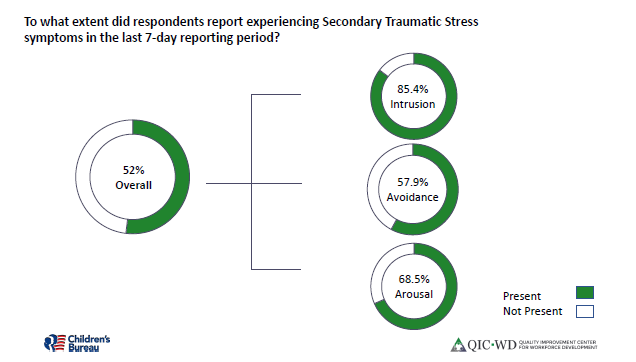Secondary Traumatic Stress Among Child Welfare Workers
There is growing evidence to suggest that child welfare workers are experiencing high levels of secondary traumatic stress (STS) as a result of exposure to traumatized clients in crisis (e.g., Barbee, et al, 2018). The Quality Improvement Center on Workforce Development (QIC-WD) surveyed 1,113 front line child welfare workers in 13 jurisdictions between November, 2017 and March, 2018 using the Bride (2007) Secondary Traumatic Stress Scale as part of a comprehensive workforce needs assessment. An average of 54% of participants reported clinical levels of STS. When these elevated numbers are compared to the original Bride research of social workers, they far exceed the 15% he found. Furthermore, when these numbers are compared to other first responder fields such as law enforcement, fire-fighting, and the armed forces (e.g., Bourke & Craun, 2014), the rates of elevated STS among child welfare workers are also much higher.
We found that while there was a range of scores on STS across individuals and jurisdictions, the percentages were highly similar. Across the 13 jurisdictions:
- 41% - 63% of child welfare workers reported experiencing intrusive thoughts (e.g., trouble sleeping or concentrating and thinking about work with clients when off the job);
- 39% - 68% reported experiencing arousal (e.g., feeling discouraged by the future, jumpy, easily annoyed); and
- 35% - 59% reported engaging in avoidance (e.g., avoiding people, places or things that remind them of their work with families) behaviors.
The percentage of frontline staff exceeding the cut off score for clinical levels of STS ranged from 40% to 63% while 54% reported clinical levels of STS in the past week. These findings raise questions not only about the state of the workforce in child welfare today, but about the implications such widespread and intense levels of STS have for the workplace, partnerships, and the families, youth and children served.
